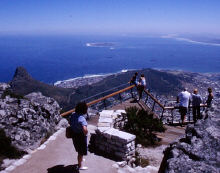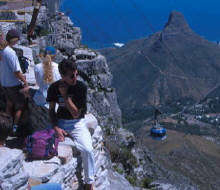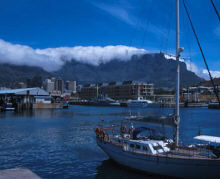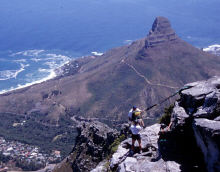Table Mountain is, without doubt, one of the world’s most recognisable mountains with its massive, flat-topped shape looming above the cosmopolitan city of Cape Town.
For centuries Table Mountain has been a guiding beacon to mariners rounding the Cape of Southern Africa – the confluence of the Atlantic and Indian Oceans, not at the Cape of Good Hope, as many believe, but at Cape Agulhas further south. Rising to more than 1000 metres with virtually sheer cliffs at many points, it was described in a seafaring journal by Sir Francis Drake as "the most stately thing and the fairest cape we saw in the whole circumference of the earth."
Cape Town, which faces north across Table Bay, has thrived from its birth, first as a Dutch settlement in 1652 when Jan van Ribeeck established it as a supply station for ships of the Dutch East India Company. Later, under the British, its expansion continued as a victualling port supplying ships with food and fresh water from the perennial mountain streams.

 View of Table Bay and Robben Island from the summit
View of Table Bay and Robben Island from the summit
This Western Cape Province is rich in dramatic coastline, fertile fishing grounds, farmland and magnificent vineyards and fine wine regions such as Franschoek, Constantia, Stellenbosch and Paarl. Table Mountain is the symbol of all that is Western Cape.
The provincal capital, Cape Town, is a sophisticated city with plenty to see and do, particularly around the Victoria and Alfred Waterfront area, where delightful buildings of the Cape Dutch and Victorian-era architecture have been restored as shops, restaurants, museums and pubs, while the busy water traffic of the docks goes on unabated.
Despite its formidable appearance, it is possible to hike up Table Mountain. The first recorded ascent was in 1503 by the Portuguese navigator Antonio da Saldanha who, confused by the Cape Peninsula geography, climbed to the summit via the frontal cleft, now known as Platteklip Gorge.
The view from the summit at 1087 m (3563 ft) is invigorating. Fortunately there is a cable car to lift visitors to the top, where an extensive stone restaurant complex provides fine food and cool beer, whilst blending beautifully into the rocky landscape.

 Cable car and the Lion’s Head
Cable car and the Lion’s Head
The cable car first opened in 1929 using gondolas of 24-people capacity. It carried more than 11 million people without an accident on the five minute, exhilarating ride to the top. The only time it would not operate was when winds exceeded 70 km/h. Then in 1997, a new cable car system was installed with larger circular gondolas having a revolving floor to give passengers a 360° view on the way up and down.
Each gondola can carry 65 passengers thus giving a passenger capacity of 890 per hour compared to 230 with the old system. Thus queues of waiting passengers have largely been eliminated except for peak times.
It is mandatory for first time visitors to Cape Town to ascend Table Mountain. The choice is by cable car or hiking. This normally separates the oldies from the exuberant youth. On this, of my many visits to Cape Town, I was accompanied by an energetic grandmother who insisted on hiking up! We made inquires at the hotel.
"It takes about 2 hours," encouraged a little old lady. "Anybody can manage it," she assured us. Not to be a spoil sport, I agreed that we set forth early next day to hike to the top.
We took a Rikki taxi to the cable car station and examined the set-up. I looked hopefully at the happy people expecting to be on the summit in 5 minutes flat. No, I wasn’t allowed to join them. Chrissy insisted on a hiking adventure. Even from the base of the mountain the view is superb. We followed the road for two kilometres further on to find the path leading to Platteklip Gorge, the "easiest" route up.
A giant’s stairway of white sandstone blocks zigzags up a scrubby slope to an oasis – a forest glade shading a cool, clear brook that issues from the gorge. Beyond this point there is no water. We drank deeply and filled our water bottles. Upwards we struggled under the glaring sun, pausing at any sign of shade.
What impresses most is the overpowering nature of the mountain – the ancient rock strata – the horizontally bedded quartzites having little white, rounded pebbles, relics of the long forgotten Devonian Age before land animals evolved. High up the gorge, the vertical rock cliffs closed around us until, at last, we broke out to blue sky on the summit table. What a relief and what a fantastic place!

 The Table Cloth from the Waterfront
The Table Cloth from the Waterfront
Not always is the sky so blue and cloudless! Table Mountain is famous for its "Table Cloth" – a thin, white cloud formation that rolls over the top like a waterfall only to dissipate halfway down the slope. Legend has it that a retired pirate, on climbing the mountain met up with the devil. In order to preserve his soul, the pirate challenged the devil in a smoking contest. So they stoked up their pipes and have been smoking ever since.
The scientific explanation is that the summer anticyclones bring warm, moisture-laden air from the south which condenses to a white cloud layer on the cooler mountain top and spills over the city side to disperse at warmer, lower altitudes.
Lunch on the summit we shared with black thrushes which were happy to be hand-fed.
The wild flowers seemed familiar – so this is where all the Australian ornamentals come from? – agapanthus, watsonias and red nerines poked out from rock crevices amid a scrub of ericas and gnarled proteas. More than 1400 species of flowering plants have been recorded on the mountain which make it a spectacular sight in the spring.
Cute guinea pig-like creatures known as rock dasssies scuttled everywhere. They are not afraid and scamper among the tourists seeking to be fed.

 The Lion’s Head from Table Mountain
The Lion’s Head from Table Mountain
The descent of the mountain is not without hazards. The high rock steps require caution if you are dependent on multi-focal glasses. Most people, shorties in particular, find the hike a gruelling experience, especially on a hot day.
We stopped frequently to admire the flowers and view, so it took us three hours to get up and two down to the road. What a memorable day’s outing! Now we can claim to have climbed Table Mountain!